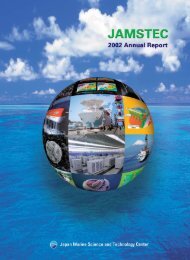2007 Annual Report - jamstec japan agency for marine-earth ...
2007 Annual Report - jamstec japan agency for marine-earth ...
2007 Annual Report - jamstec japan agency for marine-earth ...
Create successful ePaper yourself
Turn your PDF publications into a flip-book with our unique Google optimized e-Paper software.
~ 40 km ~ 20 km ~ 10 km<br />
Fig.5<br />
The sea surface height variability in centimeters. The solid line shows streamline through Drake Passage.<br />
large scale ocean circulation. In this region, mesoscale eddies<br />
may play important role in the <strong>for</strong>mation of the intermediate<br />
water. Three horizontal resolutions of 10, 20, and 40 km are<br />
used <strong>for</strong> this investigation. Figure5 shows the SSH variability<br />
evaluated as the root-mean-square of SSH. This variability represents<br />
the strength of eddy activities. For the 40 km case, the<br />
SSH variability is relatively weak. Since the de<strong>for</strong>mation<br />
than the 40 km case and 34.5 salinity water spreads along the 0<br />
=27.1 surface up to about 500 m depth. For the 10 km case, the<br />
34.5 salinity water, which is subducted along the 0 =27.1 surface,<br />
reaches more than 1400 m depth. Although the spreading<br />
of the salinity is still somewhat weak even <strong>for</strong> the 10 km case<br />
compared with the climatology salinity distribution, it is much<br />
better than the low resolution cases.<br />
radius is about 20 km at a latitude 54S, it seems that mesoscale<br />
eddies are not resolved well. For the 20 km case, the variability<br />
increases significantly from the 40 km case. The variability is<br />
high in the equatorward flank of the ACC, especially on the<br />
northern boundary of the ACC. The variability is large in the<br />
Argentine Basin and the Agulhas Retroflection region. For the<br />
10 km case, the intensity of the variability reaches about 50 cm<br />
in the Brazil-Malvinas Current confluence and the Agulhas<br />
Retroflection region. Figure6 shows the vertical section of<br />
salinity at 30 W. For the 40 km case, low salinity water is not<br />
transported downward along the 0 =27.1 surface. The 34.5<br />
salinity water reaches only about 400 m depth. For the 20 km<br />
case, the low salinity water is transported downward deeper<br />
2Development of an Integrated Earth System Model <strong>for</strong><br />
Predication of Global Environmental Changes<br />
a. Long-term climate change projection with an integrated <strong>earth</strong><br />
system model<br />
Using the integrated <strong>earth</strong> system model, we have calculated<br />
future CO 2 emission pathways allowable to achieve CO 2 stabilization<br />
at 550 ppm and 1000 ppm around year 2300 i.e.,<br />
SP550 and SP1000. It has been confirmed that, when one<br />
takes into consideration the possible feedback between climate<br />
and carbon cycle, necessary reduction of CO 2 emission is severer<br />
than it is when one does not Fig.7. It turned out that the<br />
terrestrial carbon cycle saturates rather quickly and cannot act<br />
~ 40 km<br />
~ 20 km ~ 10km<br />
Fig.6<br />
Vertical section of salinity at 30 W. The vertical axis indicates depth in kilometers. The red line denotes 0 =27.1 isopycnal.
















